Top Rankings
Alexandria Public School District ranks among the top 20% of public school district in Minnesota for:
Category
Attribute
Overall Rank
Highest overall rank (Top 20%)
Math Proficiency
Highest math proficiency (Top 20%)
Graduation Rate
Highest graduation rate (Top 10%)
Community Size
Largest student body (number of students) (Top 1%)
For the 2025 school year, there are 7 public elementary schools serving 2,572 students in Alexandria Public School District. This district's average elementary testing ranking is 8/10, which is in the top 30% of public elementary schools in Minnesota.
Public Elementary Schools in Alexandria Public School District have an average math proficiency score of 56% (versus the Minnesota public elementary school average of 47%), and reading proficiency score of 53% (versus the 51% statewide average).
Minority enrollment is 12% of the student body (majority Hispanic), which is less than the Minnesota public elementary school average of 40% (majority Black and Hispanic).
Overview
This School District
This State (MN)
# Schools
9 Schools
1,655 Schools
# Students
4,021 Students
571,925 Students
# Teachers
277 Teachers
40,363 Teachers
Student : Teacher Ratio
15:1
15:1
District Rank
Alexandria Public School District, which is ranked within the top 20% of all 522 school districts in Minnesota (based off of combined math and reading proficiency testing data) for the 2021-2022 school year.
The school district's graduation rate of 93% has increased from 90% over five school years.
Overall District Rank
#99 out of 527 school districts
(Top 20%)
(Top 20%)
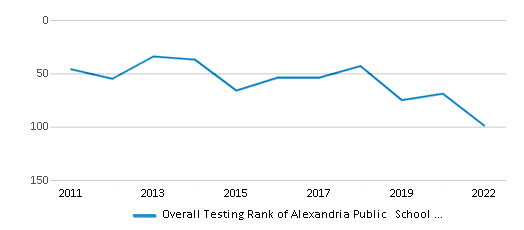
Math Test Scores (% Proficient)
54%
45%
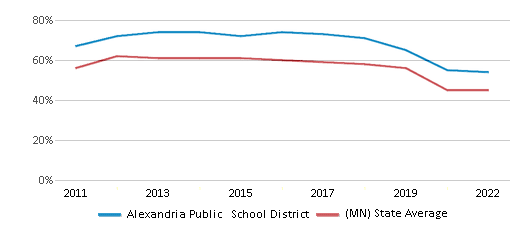
Reading/Language Arts Test Scores (% Proficient)
54%
51%

Science Test Scores (% Proficient)
43%
41%
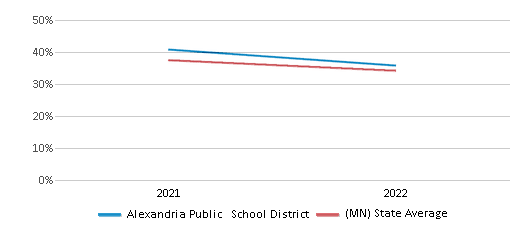
Graduation Rate
93%
84%
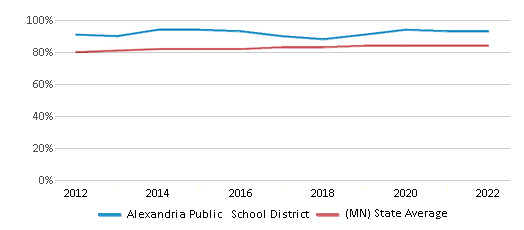
Students by Ethnicity:
Diversity Score
0.20
0.61
# American Indian Students
8 Students
10,480 Students
% American Indian Students
n/a
2%
# Asian Students
32 Students
42,165 Students
% Asian Students
1%
7%
# Hispanic Students
191 Students
65,127 Students
% Hispanic Students
5%
12%
# Black Students
26 Students
70,794 Students
% Black Students
1%
12%
# White Students
3,602 Students
344,281 Students
% White Students
89%
60%
# Hawaiian Students
2 Students
676 Students
% Hawaiian Students
n/a
n/a
# Two or more races Students
160 Students
38,402 Students
% of Two or more races Students
4%
7%
Students by Grade:
# Students in PK Grade:
139
10,698
# Students in K Grade:
279
57,031
# Students in 1st Grade:
263
61,859
# Students in 2nd Grade:
313
63,560
# Students in 3rd Grade:
275
61,751
# Students in 4th Grade:
286
63,575
# Students in 5th Grade:
282
63,290
# Students in 6th Grade:
269
63,180
# Students in 7th Grade:
303
53,666
# Students in 8th Grade:
302
53,924
# Students in 9th Grade:
327
4,107
# Students in 10th Grade:
340
4,634
# Students in 11th Grade:
331
4,740
# Students in 12th Grade:
312
5,910
# Ungraded Students:
-
-
District Revenue and Spending
The revenue/student of $17,325 in this school district is less than the state median of $17,854. The school district revenue/student has stayed relatively flat over four school years.
The school district's spending/student of $17,252 is less than the state median of $18,580. The school district spending/student has stayed relatively flat over four school years.
Total Revenue
$70 MM
$15,547 MM
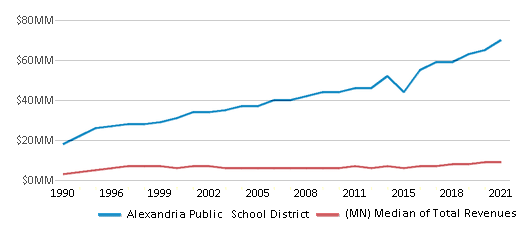
Spending
$69 MM
$16,179 MM
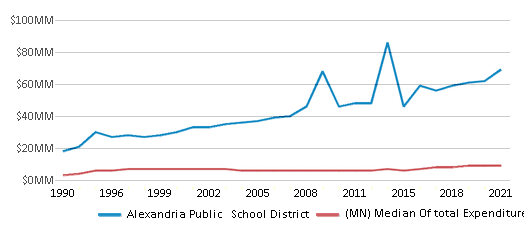
Revenue / Student
$17,325
$17,854
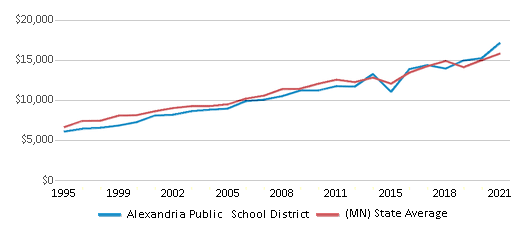
Spending / Student
$17,252
$18,580
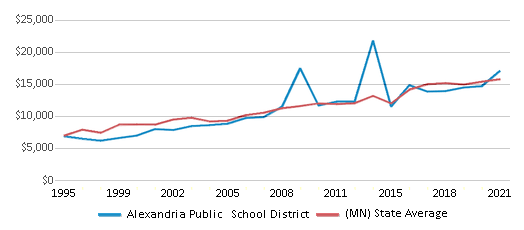
Best Alexandria Public School District Public Elementary Schools (2025)
School
(Math and Reading Proficiency)
(Math and Reading Proficiency)
Location
Grades
Students
Rank: #11.
Garfield Elementary School
(Math: 70-79% | Reading: 60-69%)
Rank:
Rank:
10/
Top 10%10
303 Sanstead St E
Garfield, MN 56332
(320) 762-3350
Garfield, MN 56332
(320) 762-3350
Grades: K-5
| 124 students
Rank: #22.
Lincoln Elementary School
(Math: 67% | Reading: 63%)
Rank:
Rank:
9/
Top 20%10
1120 Lark St
Alexandria, MN 56308
(320) 762-3320
Alexandria, MN 56308
(320) 762-3320
Grades: K-5
| 478 students
Rank: #33.
Miltona Elementary School
Magnet School
(Math: 65-69% | Reading: 55-59%)
Rank:
Rank:
9/
Top 20%10
271 Dale St
Miltona, MN 56354
(877) 736-1419
Miltona, MN 56354
(877) 736-1419
Grades: K-5
| 140 students
Rank: #44.
Carlos Elementary School
(Math: 60-69% | Reading: 50-59%)
Rank:
Rank:
8/
Top 30%10
20 N Douglas Ave
Carlos, MN 56319
(320) 852-7181
Carlos, MN 56319
(320) 852-7181
Grades: PK-5
| 113 students
Rank: #5 - 65. - 6.
Voyager Elementary School
(Math: 62% | Reading: 54%)
Rank:
Rank:
8/
Top 30%10
203 Voyager Drive
Alexandria, MN 56308
(320) 762-3325
Alexandria, MN 56308
(320) 762-3325
Grades: K-5
| 427 students
Rank: #5 - 65. - 6.
Woodland Elementary School
(Math: 62% | Reading: 54%)
Rank:
Rank:
8/
Top 30%10
1410 Mckay Ave S Ste #101
Alexandria, MN 56308
(320) 762-3300
Alexandria, MN 56308
(320) 762-3300
Grades: K-5
| 416 students
Rank: #77.
Discovery Middle School
(Math: 48% | Reading: 50%)
Rank:
Rank:
6/
Top 50%10
510 N Mckay Ave
Alexandria, MN 56308
(320) 762-7900
Alexandria, MN 56308
(320) 762-7900
Grades: 6-8
| 874 students
Recent Articles

Year-Round Or Traditional Schedule?
Which is more appropriate for your child? A year-round attendance schedule or traditional schedule? We look at the pros and cons.

Why You Should Encourage Your Child to Join a Sports Team
Participating in team sports has a great many benefits for children, there is no doubt. In this article you will learn what those benefits are.

White Students are Now the Minority in U.S. Public Schools
Increasing birth rates among immigrant families from Asia and Central and South America, combined with lower birth rates among white families, means that for the first time in history, public school students in the United States are majority-minority. This shift in demographics poses difficulties for schools as they work to accommodate children of varying language abilities and socio-economic backgrounds.





